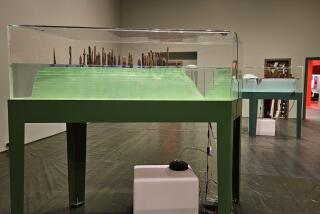LACMA: MOCA’s new old suitor
Late in 2008, when the critically revered but financially teetering Museum of Contemporary Art was mulling rival rescue plans to pull it back from the brink of collapse, two issues were paramount. More than four years later, even as news breaks of yet more proposed solutions to MOCA’s lingering distress, they still are.
One issue was the need to vastly increase the museum’s paltry endowment, which had never come close to being adequate for a 30-year-old institution whose ambitious mission -- and achievement -- was international leadership as “the defining museum of contemporary art.”
The other was autonomy. In a world where a substantial surge in mergers and consolidation marked many spheres of American life, the potential loss of a vibrant, independent cultural voice through affiliation with -- or absorption by -- another art museum was too much to ask for.
PHOTOS: Arts and culture in pictures by The Times
On Thursday the Los Angeles County Museum of Art joined USC as an avowed MOCA suitor. (A third institution, as yet unconfirmed, is also thought to be in the mix.)
LACMA has been here before. The Wilshire Boulevard museum had advanced one of the two primary rescue plans in 2008, while the Broad Foundation had proposed the other. Broad ultimately prevailed -- in part because of those two nettlesome issues.
The Broad Foundation, helmed by billionaire tycoon Eli Broad, pledged $3 million per year for five years toward exhibition funding, which removed some immediate financial pressure while maintaining MOCA’s potential program standing. The foundation also offered a modest, $15-million matching grant toward building the endowment.
Just how far LACMA could go then in securing MOCA’s finances wasn’t known. What was known is that autonomy would inevitably be lost in a LACMA merger.
Speculation was certainly rampant that the Broad Foundation had designs on MOCA’s exceptional 6,000-piece art collection, and some of that conjecture lingers today. (I tend to doubt it, and Broad has always denied it.) The foundation is currently erecting offices plus exhibition and storage facilities for its own sizable art collection directly across Grand Avenue from one of MOCA’s two buildings; it’s scheduled to open in mid-2014.
But virtually no one today believes that the Broad rescue plan for MOCA has worked out. Fundraising lags, staff has been depleted.
GRAPHIC: LACMA and MOCA at a glance
Ironically, given the museum’s stellar program and collection history, there’s nothing that a hefty infusion of endowment cash could not solve. For whatever reason, though, it hasn’t been forthcoming -- either from Broad or the many other very deep pockets on MOCA’s board of trustees.
The terms of a proposed LACMA/MOCA merger remain sketchy, and we are no doubt quite a ways off from any conclusive action. (On Thursday, LACMA director Michael Govan posted a rationale for the merger on Unframed, the museum’s blog.)
One benefit is that, unlike the dire days of 2008, the matter isn’t urgent. Exceptional care must be taken, not least because it involves a multibillion-dollar art collection largely donated by generous benefactors. But there is time for considered thought and, one hopes, transparent discussion.
LACMA has reportedly said it would preserve MOCA’s two downtown locations and operate them under the MOCA name. If a merger were to go forward -- and right now that is a very big “if” -- administrative independence for MOCA would of course be sacrificed. But a degree of institutional autonomy and security could be ensured through creation of a dedicated endowment fund.
Sources have told The Times that LACMA would agree to raise $100 million for the combined museums as a condition for completing the deal. That is certainly one place to start.
ALSO:
LACMA’s overhaul is a work in progress
Fab Four photos: Henry Grossman’s moments with the Beatles
MORE
INTERACTIVE: Christopher Hawthorne’s On the Boulevards
Depictions of violence in theater and more
PHOTOS: Arts and culture in pictures
More to Read
The biggest entertainment stories
Get our big stories about Hollywood, film, television, music, arts, culture and more right in your inbox as soon as they publish.
You may occasionally receive promotional content from the Los Angeles Times.











